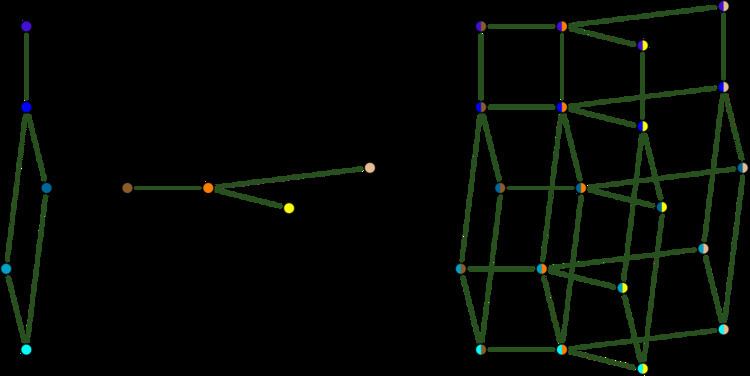 | ||
In graph theory, the Cartesian product G
Contents
Cartesian product graphs can be recognized efficiently, in linear time. The operation is commutative as an operation on isomorphism classes of graphs, and more strongly the graphs G
The notation G × H is occasionally also used for Cartesian products of graphs, but is more commonly used for another construction known as the tensor product of graphs. The square symbol is the more common and unambiguous notation for the Cartesian product of graphs. It shows visually the four edges resulting from the Cartesian product of two edges.
Examples
Properties
If a connected graph is a Cartesian product, it can be factorized uniquely as a product of prime factors, graphs that cannot themselves be decomposed as products of graphs. However, Imrich & Klavžar (2000) describe a disconnected graph that can be expressed in two different ways as a Cartesian product of prime graphs:
(K1 + K2 + K22)where the plus sign denotes disjoint union and the superscripts denote exponentiation over Cartesian products.
A Cartesian product is vertex transitive if and only if each of its factors is.
A Cartesian product is bipartite if and only if each of its factors is. More generally, the chromatic number of the Cartesian product satisfies the equation
χ(GThe Hedetniemi conjecture states a related equality for the tensor product of graphs. The independence number of a Cartesian product is not so easily calculated, but as Vizing (1963) showed it satisfies the inequalities
α(G)α(H) + min{|V(G)|-α(G),|V(H)|-α(H)} ≤ α(GThe Vizing conjecture states that the domination number of a Cartesian product satisfies the inequality
γ(GAlgebraic graph theory
Algebraic graph theory can be used to analyse the Cartesian graph product. If the graph
where
History
According to Imrich & Klavžar (2000), Cartesian products of graphs were defined in 1912 by Whitehead and Russell. They were repeatedly rediscovered later, notably by Gert Sabidussi (1960).
